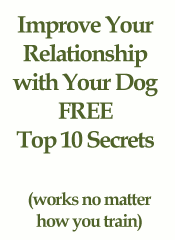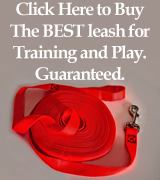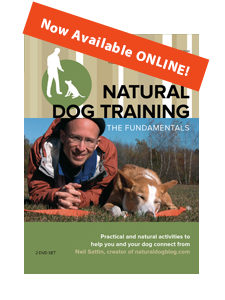A year or so ago, I was walking my dog through our in-town neighborhood, when out of nowhere a LARGE shepherd mix came bounding towards us (without a leash) with trouble on her mind. Having worked so frequently with aggressive dogs I could see that for whatever reason, this dog had seen us coming and decided that Nola might be good for lunch - and there was no owner in sight. Since it takes two to tango, my first step was to keep Nola from engaging in the aggression. I gave her a "Down!", and she hit the bricks (on the sidewalk), and she stayed there although her teeth were bared and she was beginning to growl. I kept myself between the two dogs, as I could tell that the dog didn't want any piece of me - just my dog, and I effectively herded the dog away from Nola, who stayed there on the ground despite all of the commtion. Eventually my firm shouts of "No!" and "Go on!" at the other dog must have aroused the owner's attention, as they came running out of the house to grab their dog. While I did return later (without Nola) to tell the owner that an offleash uncontrolled attack dog was kinda "bad form", the point of my telling you this story is to show you how useful a resolute down/stay in an energized situation can be. In part one of this series, we taught our dog how to sit using our body language and our dog's natural response to waiting while in hunting mode. We used a small platform ("on the box") as a way to delimit space for our dog, an aid in Sparky's figuring out what to do. In part two of this series, we went from "Sit" to "Down" - also using the box - in order to teach our dog the feeling of lying down in an energized state. Obedience matters most when your dog is "distracted" (absorbed in the energy of their environment) - and the only way for you to be able to reach your dog during these moments is for your dog to be familiar with the feeling of engaging in obedience behaviors WHEN energized. In this lesson, we're going to work on "Stay", and the Down/Stay will become an essential part of your training regimen.
What does it mean to "Stay"?
The concept is simple enough: you tell your dog to "stay" and your dog remains in that one place. However, the "stay" is only effective as long as the energy of your dog's environment keeps your dog rooted in place. Otherwise, something "out there" could become more attractive to your dog than the staying, and your dog's prey drive will kick into action to chase that bicycle, grab that treat, etc.
I'm telling you this because I want you to see the stay not as an exercise of your dog's willpower. Since dog's are more feeling-oriented than thought-oriented, their willpower won't hold up under duress. You are going to be teaching your dog how to be more and more rooted in their spot as more energy is added to the system. It will feel good to your dog to remain where they are. Picture your dog lying in an attentive down (the "down" you elicited in part two), and now imagine a current of energy flowing through your dog, down into the ground, back up into your dog - in a circuit. If you can keep your dog relaxed, you will be able to add more energy to the system, and that circuit will spin faster and faster. The intensity of the circuit will work like a magnet, holding your dog rooted to that spot. In a sense, you are teaching your dog to "feel the flow" - the same flow that they feel when they're playing tug-of-war with you - while lying there in one spot. Just like electrical magnetism builds as you increase the current in a coil of wire, the emotional magnetism will increase the faster the emotional circuit spins. The important factors for YOU to control are keeping your dog relaxed and gradually adding more and more energy to the system.
Making the "stay" happen
OK, so you've gotten your dog onto the box and into the down position. You can still be totally in the realm of body language and hand signals, but if you've introduced your voice that's fine too. At the initial stages of this training, I'll often progress from "on the box" to "sit" to "down" - but frequently a dog will just go into the "down" at the first whiskaway - it's the internal efficiency mechanism at work. That's good, because down is ultimately what you're after (and a much more useful command, IMHO).
The hand signal that I use for "Stay" is my left hand extended in front of me, palm out, fingers pointed to the sky - as if you were signalling someone to "Stop right there!". Your hand should be extended with the "stop right there" attitude as well - because your intent (which matters) is for your dog to remain in place, completely rooted to their spot. I'm going to explain the progression as I go through it with a very energized (and prone-to-popping-up-from-the-down) dog - if your dog stays rooted easily, then you can move through the series rather easily.
- Get your dog into the down position - you may need to be crouched in order for this to happen.
- Feed the position with your right hand.
- Hold out your left hand in the "Stay right there" position.
- Keep feeding the position, while you SLOWLY raise your body.
- Once you're standing, feed the position some more.
Good - you got to a standing position, and your dog is still energized. You're standing more or less next to your dog - maybe slightly in front, but not directly in front. Now for the next step.
- Take a few steps in place. As if you were marching in place. Just start by shuffling your feet a little - slowly and gradually. Your left hand is still extended in the "stay right there" position.
- Feed the position.
- Start taking stronger steps. By "stronger" I mean to gradually increase the force with which you're feet are hitting the ground. You could also start increasing the pace of your steps.
- Feed the position.
This would probably be a good time to take a break. Give your dog a "Ready...Sparky!" - and then run away from the box. Your dog will spring off the box after you, and you should do some pushing together (or some tug-of-war), before you get back on the box. Lots of praise at this point! OK, back to the box.
- Work your way up to where you were before.
- Add more energy to the system. Run in place.
- Feed the position.
- Jump in the air. Just a small jump, but both feet leave the ground.
- Feed the position.
- Jump higher. Feed the position. Go crazy. Feed the position.
- Give a slow, gradual tug on the leash. Feed the position.
- Give a couple quick jerks on the leash. Feed the position.
Maybe you're getting the spirit at this point? You're near your dog and gradually upping the ante with energy that you add to the moment, each time keeping your dog in place with your "stay in position" hand and by feeding the position as soon as your dog has succeeded.
Make sure that you take breaks after your dog reaches each milestone to push and play. Then get your dog back on the box and take it to the next level.
What to do if your dog pops back up from the down position
You have a couple choices at this point. If you catch your dog as they're about to get up, you can actually preemptively call your dog off the box. Or you can use your food hand (with a whiskaway) to get your dog back into the "down" position. Your dog's popping up is a sign that you added too much energy to the system - so take it more slowly. Allow your dog to educate you in terms of the correct pace of training, which will ensure that you're building upon multiple successes with your dog - if you're too focused on your agenda then you might set your dog up to fail too often. A "failure" here and there (which is really a sign that you failed to work at a slow enough pace) is ok, but too many will undermine your dog's confidence. Slower and more gradual is ALWAYS better.
Some variations to get you to the next level
- Back away from the box with your "stay" hand outstretched. Back away slowly a few feet. Then go back and feed the position. Back away a few feet more this time. Give your dog a "Ready..." - but instead of calling them off the box (make sure your hand is still in the "stay right there" position as you say "ready") move back in and feed the position. Back away a third time, and this time say "Ready..." - then drop your "stay hand", call your dog off the box with their name, and do some pushing and tug. Gradually increase your distance from the box. If your dog has the tendency to pop up when you move away, you can keep a slight amount of tension on the leash, and your dog should counteract that tension by becoming more rooted in their place on the box.
- Circle your dog. Start circling (counterclockwise) in close proximity to your dog. Sometimes at the beginning of circling I'll actually drop a handfull of food on the box right under a dog's mouth, so that they're distracted with eating the food while I circle around them. You might also need to maintain contact with a hand (keep your left fingertip on their head while giving the "stay" gesture with your right hand) as you circle around. When you come back around to your dog's right side, feed the position, and take a break to give your dog a little relaxing massage. Try to circle around at greater and greater distances.
Important note on circling:
As you circle around, there are two things for you to do that will help your dog stay in position. First thing is - instead of keeping your left hand out in a "stay" position as you circle around, allow your arms to swing freely (as they normally do when you walk) - you might even exaggerate the movement. Every couple of swings of your left arm, extend your hand out in the "stay" position towards your dog (at this point I'm also saying "Stay!" as I present my left hand). Your movement helps keep your dog focused on you, and helps establish a rhythm for what you're doing - which will make the exercise more predictable for your dog. So that's tip #1.
Tip #2: The place where your dog is most likely to pop up as you make your circle is when you're directly behind your dog, out of sight. So, take note of where that is (you'll notice that your dog will probably move their head from one side to the other as they try to pick you up in their field of vision), and give your dog a "Stay" right before you leave their sight. Then walk faster until you're back in your dog's field of vision. Try to time another "Stay" so that your dog sees the "stay" gesture (and hears "Stay") at the instant that they regain sight of you.
Especially as you move out to greater and greater distances, when you come back around to your dog's side feed the position, take a moment to help your dog relax now that you're back, and then call your dog off the box for some play. The play (and/or pushing) is a way to help your dog relieve any residual tension that they have from each phase of the exercise.
Conclusion
Over time your dog will develop a steadfast "stay", and you'll be able to move away further - to the point where you're even completely out of sight. You can hide for a few moments behind a tree, or leave your dog in the backyard as you circle around your house - the options for working with the stay are endless. The trick is to always remember to take play time between "stays" to help release any excess stress, to keep your dog energized throughout the down/stay, and to be VERY GRADUAL in the amount of energy (and or distance) that you add to your down/stay repertoire. Ultimately the down/stay will be an important tool for you in your relationship with your dog - you'll be able to use it to instantly defuse any highly energized or tense situation, or to just keep your dog out of the way while the family eats dinner. Take it slow, practice consistently, keep it fun, and, as always, let me know if you have any questions.





When and how do you fade the additional environmental cue of the 'box' as well as the food lures?
Hi Marion,
When a dog can stay while you're circling at a reasonable distance (say something in the 30-50 foot range) that's a good time to start working the down/stay training into play.
You might use another raised object instead of the box (a rock, or a park bench) as a transition or to help generalize - or you CAN just use nothing at all. Just remember that a change in circumstances sometimes means that you need to step back your expectations. In other words, if you start using "no box", then you will probably have to start off with smaller distances - don't try to immediately jump into circling at 50 feet.
At that point you can also start using a tug object (i.e. play tug-of-war on release) as an alternative to the food. Just make sure you let the dog win!
Thanks for your question.
Thanks for the explanation, Neil. I understand what you mean about fading the box, generalising the stay and reducing criteria when any of the stimuli are changed.
Do you find that starting with the box really makes a difference to how well the dog learns the stay as opposed to teaching the stay without the box to start with? I'm just thinking that if you don't use the box in the first place then there's one fewer stimulus to fade or generalise, but perhaps the box provides an 'anchor' for the dog in the initial stages.